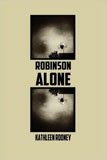March 20, 2013ROBINSON ALONE
Review by Kristina Marie Darling
Gold Wake Press
5108 Avalon Drive
Randolph, MA 02368
ISBN: 978-0-9837001-4-2
2012, 132 pp., $12.95
goldwakepress.com
In Kathleen Rooney’s Robinson Alone, epistolary poems appear alongside lyric fragments, found text, and carefully crafted tercets. Although formally diverse, the collection is gracefully unified by its concern with literary tradition, artistic legacy, and the gender politics of canon formation. Frequently drawing inspiration from the life and writings of poet Weldon Kees, Rooney offers a thought-provoking discussion of these broader issues, all the while keeping her poems grounded in the tangible details offered by a fascinating life in the arts and letters.
With that said, Rooney frequently blurs the boundaries between Kees’ work and that of more well-known literary figures, most notably John Berryman, suggesting the arbitrary nature of canon formation. The book draws numerous parallels between the two writers and their work, as Robinson (a figure from Kees’ poems) often resembles Henry from Berryman’s The Dream Songs. As the book unfolds, Rooney prompts the reader to consider why the two bodies of work met such vastly different fates, with Berryman being widely read and Kees fading into relative obscurity. She writes in “Robinson Walks Museum Mile”:
… Do museums
amuse him? Yes, but not today. Would he
like to be in one? Of course. Why not?
An object of value with canvas wings,
an unchanging face in a gilt frame, arranged—
thoughtless, guilt-free, & preserved
for eternity. Robinson doesn’t want to be
exceptional. He knows he is. He wants to be
perceived exceptional.
Here Rooney underscores the subjectivity of cultural gatekeeping practices, presenting “the museum,” with its “objects of value” and “gilt frames,” as a completely arbitrary construction. In doing so, Rooney’s smallest technical decisions illuminate, and often complicate, the piece itself. This poem in particular creates a thought-provoking discontinuity between form and content. By presenting the piece in couplets, she invokes one of the most canonical literary forms, and proceeds to describe Robinson’s (and in many ways Kees’) obscurity. In doing so, she raises several provocative questions: Can an individual be restored to the existing literary cannon after the fact? Who is authorized to complete these kinds corrective gestures? What does it mean for a woman poet to restore the work of a forgotten male writer to the literary mainstream? As Rooney explores possible answers, the poems in this collection, like “Robinson Walks Museum Mile,” prove to be as meditative as they are finely crafted.
Rooney’s use of found text also proves impressive as the book unfolds. Frequently repurposing shaving ads from the time period that Kees inhabited, the poet uses them to raise fascinating questions about constructions of masculinity in culture, as well as the ways that normative ideas about gender shape artistic legacies. As the book unfolds, Rooney suggests that individuals who fail to fit within this paradigm frequently find themselves excluded from existing literary canons. The found text used within the collection adeptly underscores the prevalence of normative ideas about gender, suggesting that their introduction into artistic life remained inevitable. Consider “Ann Insists on Reading the Burma-Shave Ads Out Loud”:
Modern man
Spreads it on
Pats it in
Shaves it off
See him grin
Burma-Shave
Rooney subtly highlights the enduring connection between consumer culture, masculinity, and literary legacies. Because Robinson (and perhaps Kees) fail to fit within the commercialized culture that surrounds them, the two have found enduring literary recognition unattainable, although it was most likely deserved. The title of the poem complicates the found text in proactive ways, suggesting that Ann (Robinson’s wife) brings her husband’s shortcomings to his attention by reading this ad aloud to him. In many ways, Rooney highlights the pressures surrounding men of Kees’ time, which ranged from conformity to the consumption of consumer goods. Like other pieces in the collection, this poem proves to be adeptly crafted and well-placed within the narrative arc of the book, as it problematizes much of what came before it. With that in mind, a great deal of the work in Robinson Alone lends itself to multiple careful readings. Kathleen Rooney’s Robinson Alone is a spectacular book, as thought-provoking as it is lyrical and well-crafted.